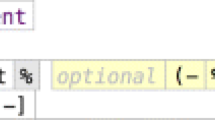Abstract
Generation of test benches for large DSP behavioral models is a complicated, labor intensive task. Also, tests generated manually satisfy no formal definition of completeness. To address these needs, high level approaches to test bench development are employed which relieve the modeler of the details of this task. High level design tools are used to develop the test bench VHDL code. The test bench code models sensors which drive the Model Under Test (MUT). Data files which can also drive the MUT are prepared by environmental data generators. The system specification values are linked to the testbench via requirements capture tools and test plans. Intelligent interfaces are used to control the development and simulation of the test bench. The approach is applicable to the testing of any DSP system modeled in the VHDL language. It provides the modeler with the capability to rapidly test DSP models and adjust the model test environment to frequent changes in system requirements.
Similar content being viewed by others
References
M.A. Richards, “The RASSP program: Overview and accomplishments,”Proceedings of the 1st Annual RASSP Conference, Arlington, VA, Aug. 15–18, 1994, pp. 1–8.
J.R. Armstrong and F.G. Gray,Structured Logic Desing with VHDL, Prentice Hall, Englewood Cliffs, NJ, 1993.
J.R. Armstrong, G. Frank, S. Hrishikesh, P. Gowrisankaran, and Z. Xu, “Test becch development for RASSP DSP models,”Proceedings of the First Annual RASSP Conference, Arlington, VA, Aug. 15–18, 1994, pp. 91–96.
F.G. Gray and J.R. Armstrong, “Reutilizaton of VHDL testbench and library components,”Proceedings of the 1994 American Institute of Aeronautics and Astronautics, San Antonio, Texas, March 28–30, 1995, pp. 691–700.
J.R. Armstrong and G. Frank et al., “High level generation of VHDL test benches,”Proceedings of the Spring VHDL International Users Forum, pp. 6.23–6.34, April 1995.
C.H. Cho and J.R. Armstrong, “The B algorithm: A behavioral test generation algorithm,”Proceedings of the International Test Conference, pp. 968–979, Fall 1994.
S. Kapoor, J.R. Armstrong, and S.R. Rao, “An automatic test bench generation system,”Proceedings of the VHDL International Users Forum, pp. 8–17, Spring 1994.
G.A. Frank, “The evolution of external models for simulation”,Proceedings of the Systems Design Synthesis Technology Workshop, Naval Surface Warfare Center, Silver Spring, MD, Sept. 10–13, 1991.
IEEE Standard VHDL Language Reference Manual, IEEE, New York, 1988.
Ascent Logic Corporation,RDD-100 User's Guide, Release 4.
The Math Works Inc.,MATLAB Reference Guide, Oct. 1992.
B. Zuerndorfer and G.A. Shaw, “SAR processing for RASSP application,”Proceedings of the 1st Annual RASSP Conference, Arlington VA, Aug. 15–18, 1994, pp. 253–268.
G.A. Shaw, “Synthetic aperture radar image processor—RASSP benchmark”, M.I.T. Lincoln Laboratory, Jan. 1994.
S. Campana, “Passive electro-optical systems”,The Infrared & Electro-Optical Systems Handbook, ERIM, Ann Arbor, Michigan, 1993.
S. Hrishikesh, Behavioral Test Bench Development For DSP Models, Masters Thesis, Bradley Department of Electrical Engineering, Blacksburg, VA, March 1995.
i-Logix,Express V-HDL Reference Manual, i-Logix, Inc., Burlington, MA, Vol. I, Version 3.0, Dec. 1993.
Comdisco Systems, Inc.,Signal Processing Work System/The DSP Framework, 1992.
Z. Xu, Modeling SAR Signals and Sensors using VHDL, Masters Thesis, Bradley Department of Electrical Engineering, Blacksburg, VA, Feb. 1995.
P. Gowrisankaran, Structural Test Bench Development for DSP Models, Masters Thesis, Bradley Department of Electrical Engineering, Blacksburg, VA, March 1995.
Synopsys Graphical Environment User Guide, Version 3.0, Dec. 1992
Demaco, Inc.,User Manual for x-Patch, Sept. 15, 1993.
Arete, Associates,IRTOOL Reference Manual, Feb. 1995.
Office of Naval Research, “Infrared Analysis Measurements and Modeling Program-Data Catalog,” Jan. 1994.
Synopsys VHDL System Simulator—Command Reference Manual, Version 3.3b, Sept. 1995.
Vantage Analysis Systems, Inc.,Vantage Spreadsheet User's Guide, Vols. I and II, 1992.
D. Harel, “STATECHARTS: A visual formalism for complex systems”,Science of Computer Programming, North-Holland, Vol. 8, pp. 231–274, 1987.
D. Gajski, F. Vahid, S. Narayan, and J. Gong,Specification and Design of Embedded Systems, Prentice Hall, NJ, 1994.
IEEE Standard 1029.1-1992—Wave Form and Vector Exchange Specification.
Cadence, Inc.,SPW—The DSP Framework, User's Guide, March 1994.
Author information
Authors and Affiliations
Rights and permissions
About this article
Cite this article
Armstrong, J.R., Frank, G. & Gray, F.G. Efficient approaches to testing VHDL DSP models. J VLSI Sign Process Syst Sign Image Video Technol 14, 221–234 (1996). https://doi.org/10.1007/BF00925501
Received:
Revised:
Published:
Issue Date:
DOI: https://doi.org/10.1007/BF00925501




